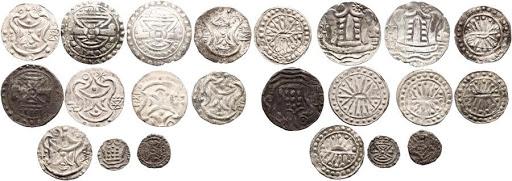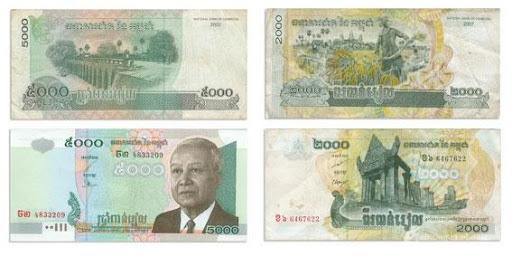
Currency in Cambodia
The Riel has not always been the official currency of Cambodia; the country's currency has undergone significant changes over the centuries, both in form and name! Although Cambodia only issued its own currency after gaining independence in 1953, coins had been in circulation for over 2,000 years, even before the rise of the Angkor Empire in the 9th century.
The beginnings of currency
Starting in the 1st century AD, the Funan Empire, the first kingdom to emerge in the region, covered much of Southeast Asia, including Cambodia, southern Vietnam, parts of Laos, Thailand, and Myanmar, before being absorbed by Chenla in the 6th century.
The ancient Khmers under the Funan Empire developed currency, religion, and trade with India. In fact, the creation of currency seems to have developed from India, which itself was influenced by the Greek and Roman empires that occupied the Indian subcontinent during antiquity.
Archaeologists have found many metal, silver, and gold coins dating back to the 4th century near the Angkor Borey archaeological site in Takeo Province. These currencies came in all shapes and sizes, from round coins to semi-round, quarter-sized, and even one-sixth-sized coins. A round coin could buy a cow, while a semi-round coin could buy a pig or something smaller. Even today, people in Angkor Borey sift through the riverbanks in search of gold coins!
Currency bills from the Funan era featured decorations such as snails, suns, moons, and portraits of Lakshmi, the wife of Lord Vishnu.

(Coins from the 4th century found in Cambodia)
Currency and economic development
Numerous artifacts such as copper notes, mirrors, Buddhist statues, and ceramics show that the Funan Empire was wealthy and powerful, benefiting from abundant natural resources and thriving trade. Moreover, the empire represented progress in Hindu and Buddhist beliefs and prosperity for the nation.
They were then able to develop their own currency. Currency played a central role in facilitating commercial activities, daily life, and national and international exchanges.
The creation of paper money strongly contributed to the development of global maritime trade. The Funan Empire transitioned from a family-based economy to a community economy, then to a social economy, eventually becoming part of the global economy through maritime trade with other empires like those of India and China. At that time, the O'Keo port of the Funan Empire was a major hub for trade between India and China.
King Kan produced many types of currency for his people, such as the Sleung and Snok coins in the 16th century. Recently, Cambodians discovered a gold coin dating back to the Chenla era, between the 4th and 7th centuries. Many coins depicting ancient Cambodian cities have yet to be discovered. The tradition of trade played a significant role in the development of the economy.

(Angkor Wat during the Khmer Empire)
Colonial currency
Currency was continuously used by the Khmer people until King Ang Duong, who ruled the kingdom between 1848 and 1860, just before the arrival of the French colonists in 1863. The French colonial government was the first to introduce paper money in Cambodia.
After Cambodia was integrated into French Indochina (Cambodia, Laos, and Vietnam), the Banque de l'Indochine was established in 1875. A branch was set up in Phnom Penh and became the issuing bank for all of Indochina from February 22, 1891, until December 31, 1951. The Indochina piastre was introduced, which was divisible into 100 cents.
On December 31, 1951, the exclusive privilege of issuing currency was transferred to the Institute of Currency Emission of the States of Cambodia, Laos, and Vietnam, which also had its headquarters in Phnom Penh. Although separate notes were issued for Cambodia, Laos, and Vietnam, the bills were uniform across the three states.

(Indochina Piastre, introduced by the first French colonists in 1848)
The return to national currency
It was only when King Norodom Sihanouk achieved full independence from France on November 9, 1953, that Cambodia was able to issue its own currency. The National Bank of Cambodia, established in December 1954, successfully launched the new riel (KHR) on January 1, 1955. Cambodia could then determine the value of its currency, the amounts to be issued, monetary advances to the government, and establish its commercial policy and customs duties. The riel was divisible into 100 sen, equal to the existing piastre, which was fully replaced by September 1955.
The riel continued to be used until 1975, when the Khmer Rouge overthrew the government, abolished money, destroyed the National Bank of Cambodia, and introduced a barter economy. Under the Khmer Rouge regime, new bills were printed depicting the Khmer Rouge defending the country against capitalists, but these were never issued.
After the Vietnamese invasion in 1979, the riel was reintroduced as the Cambodian currency on April 1, 1980. Due to the fragility of the post-war economy, the central government distributed new bills to the population to encourage their use.
In rural areas, the riel was used for practically all purchases, big and small. In Battambang and other areas near the Thai border, such as Pailin, the Thai baht was also accepted.

(The face of current King Norodom Sihamoni appears on the rare 100,000 riel bills)
The arrival of the dollar
To maintain peace and facilitate the country's disarmament, the United Nations Transitional Authority in Cambodia (UNTAC) took over the administration of Cambodia in 1992. To stimulate the local economy, UNTAC decided to inject a large amount of U.S. dollars into the country, spending approximately $1.7 billion, or about 75% of Cambodia's GDP at the time.
Currency in Cambodia became a "dual currency" system. The riel continued to coexist locally with the U.S. dollar, which was often regarded as the country's unofficial second currency. U.S. dollars represented 80% of the actual currency in circulation! Today, the exchange rate is 1 USD = 4053 KHR = 0.86 EUR. Over 90 countries around the world employ this "dollarization" policy to promote market development.

(A withdrawal of the dollar today in Cambodia would greatly disrupt the economy and cause high inflation.)
The riel today
Instead of abruptly de-dollarizing the economy, which could disrupt macroeconomic stability and growth, such as through capital outflows, the National Bank of Cambodia encourages the gradual use of the riel and market mechanisms.
To promote the use of riel bills, they are decorated with images that evoke Cambodian heroes, the people, and economic development to foster solidarity. This effort is supported by the riel's stable value and its daily use in most rural areas.
Riel bills also represent historical and cultural events, as well as the progress of the economy. The smiling face of a farmer harvesting rice appears on the back of the 2,000 riel bill, recognizing the vital importance of the agricultural sector. On the other side, a triumphant depiction of the Preah Vihear temple, inscribed as a UNESCO World Heritage site in 2008, highlights the richness of Cambodian culture.